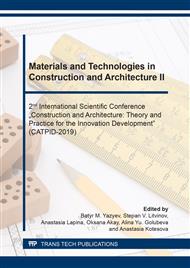[1]
O. Figovsky, D. Beilin, N. Blank, et al, Development of polymer concrete with polybutadiene matrix, Cement and Concrete Composites. 18 (1996) 437-444.
DOI: 10.1016/s0958-9465(96)00036-4
Google Scholar
[2]
T.V. Makarova, Effective building composites based on liquid stereoregular polybutadiene rubber, Diss. PhD of tech. sciences: 05.23.05, Voronezh,(1998).
Google Scholar
[3]
O. Figovsky, New polymeric matrix for durable concrete, Proceedings of the International Conference on Cement Combinations for Durable Concrete. (2005) 269-276.
DOI: 10.1680/ccfdc.34013.0029
Google Scholar
[4]
D. V. Panfilov, Dispersed reinforced building composites based on polybutadiene oligomer, Diss. PhD of tech. sciences: 05.23.05, Voronezh, (2004).
Google Scholar
[5]
Yu. M. Borisov, D. V. Panfilov, S. V. Kashtanov, Ye. M. Yudin, Construction dispersed reinforced composites, Structural mechanics and design. 2 (2010) 32-37.
Google Scholar
[6]
A. E. Polikutin et al, Experimental Research of the Durability, Crack Resistance of the Normal Sections of Bending Elements Produced of Rubber Concrete with Fiber and their Deformability. Materials Science Forum. 931 (2018) 232-237.
DOI: 10.4028/www.scientific.net/msf.931.232
Google Scholar
[7]
A.E. Polikutin, Yu.B. Potapov, A.V. Levchenko Experimental research of the effect of dispersive reinforcement on the strength of normal sections of bending elements of rubcon, Izvestiya vysshih uchebnyh zavedenij, Stroitel'stvo, Novosibirsk. 8 (2018) 28-35.
Google Scholar
[8]
V. A. Chmykhov, Rubber concrete resistance to aggressive environment, Diss. PhD of. tech. sciences: 05.23.05, Voronezh, (2002).
Google Scholar
[9]
Nguyen Phan Dhuy, Double-layered, rubcon-concrete bending elements of building structures, Diss. PhD of tech. sciences: 05.23.01, Voronezh, (2010).
Google Scholar
[10]
Yu. M. Borisov, A. E. Polikutin, Nguen Fan Dhuy, The Stress-strain state of normal sections of two-layer, rubcon-concrete bending elements of building structures, Scientific Herald of VSUACE Architecture and construction,, Voronezh, 2010 18-24.
Google Scholar
[11]
Yu.B. Potapov, S.A. Pinaev, A.A. Arakelyan, A.D. Barabash, Polymer-cement material for corrosion protection of reinforced concrete elements, Solid State Phenomena. 871 (2016) 104-109.
DOI: 10.4028/www.scientific.net/msf.871.104
Google Scholar
[12]
Potapov Y., Polikutin A., Panfilov D., Okunev M. Comparative analysis of strength and crack resistance of normal sections of bending elements of T-sections, made of rubber concrete, rubcon reinforcement and concrete, MATEC Web of Conferences. 73 (2016) https://doi.org/10.1051/matecconf/20167304018.
DOI: 10.1051/matecconf/20167304018
Google Scholar
[13]
S. A Pinaev, et al. Application of Polymer-cement Corrosion Protection for Different Strength Concrete of Reinforced Concrete Elements. IOP Conference Series: Materials Science and Engineering, 463 (2018) https://doi.org/10.1088/1757-899X/463/3/032012.
DOI: 10.1088/1757-899x/463/3/032012
Google Scholar
[14]
Fangping Liu, Jianting Zhou, Experimental Research on Fatigue Damage of Reinforced Concrete Rectangular Beam, KSCE Journal of Civil Engineering. 9 (2018) 3512-3523.
DOI: 10.1007/s12205-018-1767-y
Google Scholar
[15]
I.-H. Yang, C. Joh, K.-C. Kim. A Comparative Experimental Study on the Flexural Behavior of High-Strength Fiber-Reinforced Concrete and High-Strength Concrete Beams, Advances in Materials Science and Engineering №7390798 (2018).
DOI: 10.1155/2018/7390798
Google Scholar
[16]
Lili Sui, Qianli Zhong, Kequan Yu, Feng Xing, Pengda Li, Yingwu Zhou. Flexural Fatigue Properties of Ultra-High Performance Engineered Cementitious Composites (UHP-ECC) Reinforced by Polymer Fibers, Polymers. 8 (2018) 892.
DOI: 10.3390/polym10080892
Google Scholar
[17]
S. Chen, R. Zhang, L.-J. Jia, J.-Y. Wang. Flexural behaviour of rebar-reinforced ultra-high-performance concrete beams, Bulletin of Concrete Research. 19 (2018) 997-1015.
DOI: 10.1680/jmacr.17.00283
Google Scholar
[18]
V.I. Travush, D.V. Konin, A.S. Krylov. Strength of reinforced concrete beams of high-performance concrete and fiber reinforced concrete, Bulletin of Civil Engineering. 1 (2018) 90-100.
Google Scholar
[19]
A.M. Korneev, O.P. Buzina, A.V. Suhanov, Deterministic mathematical model and algorithm for analysis of stress-strain state of bending elements with discrete fibers, Modern Scientific Technologies. 9 (2016) 57-62.
Google Scholar


